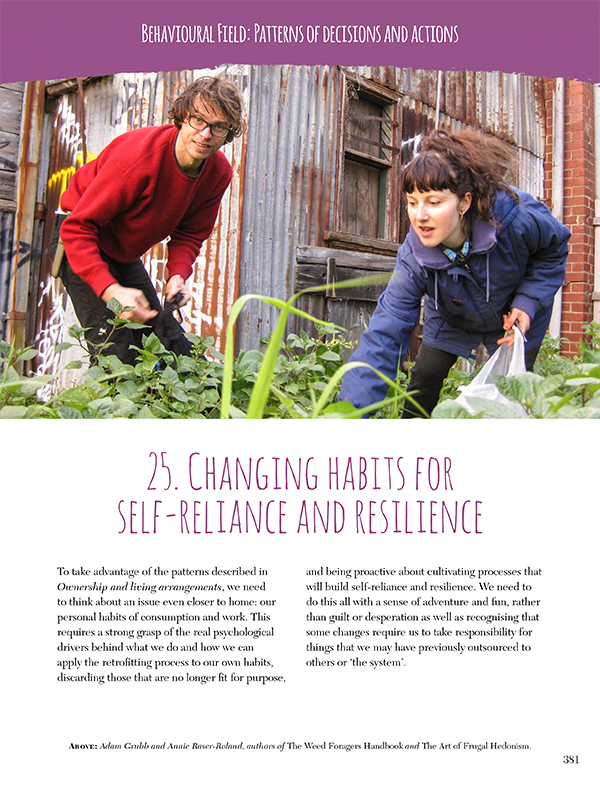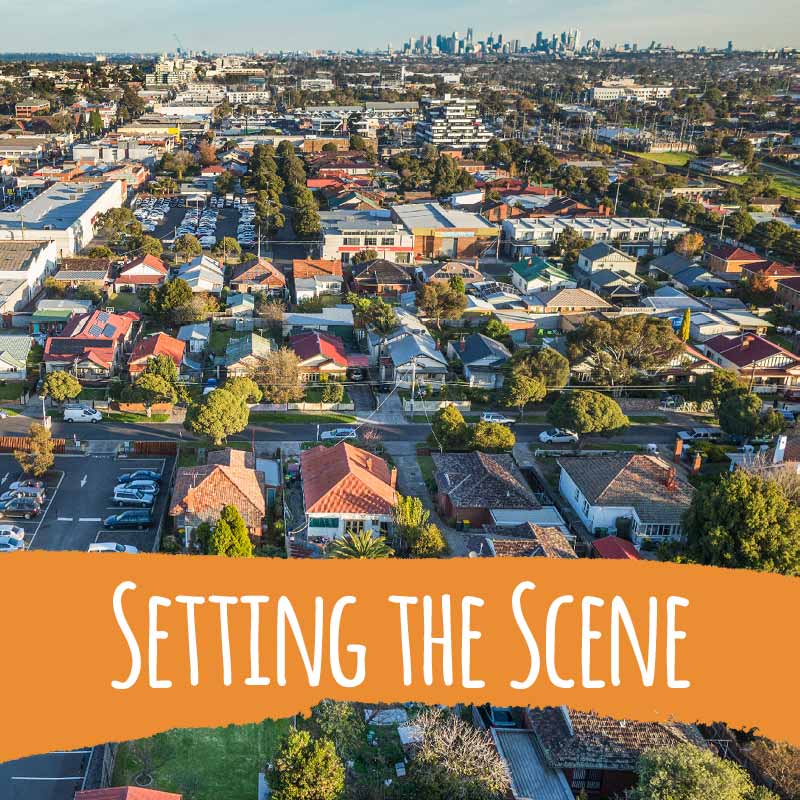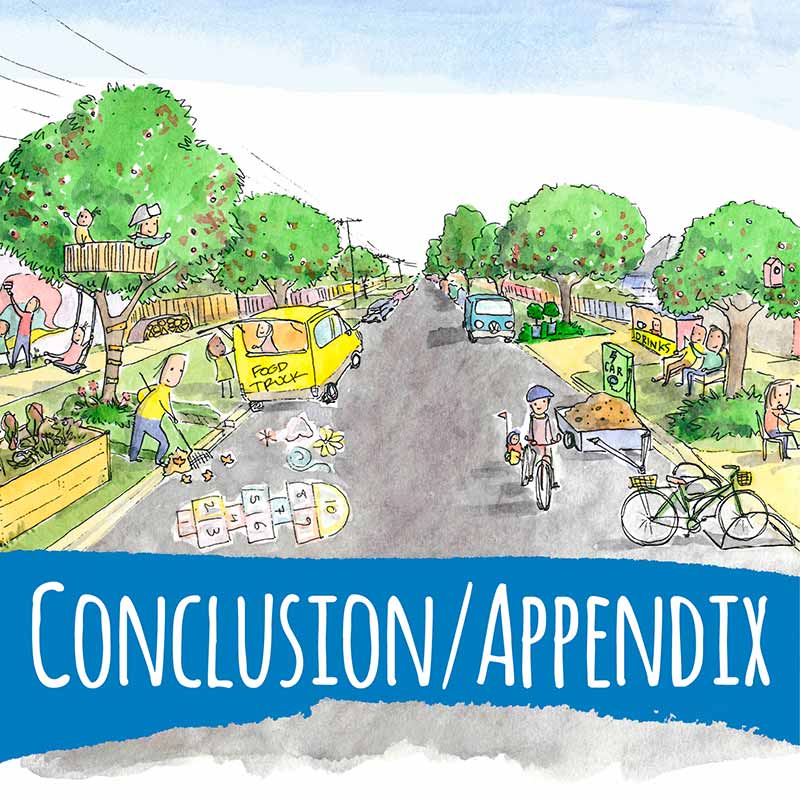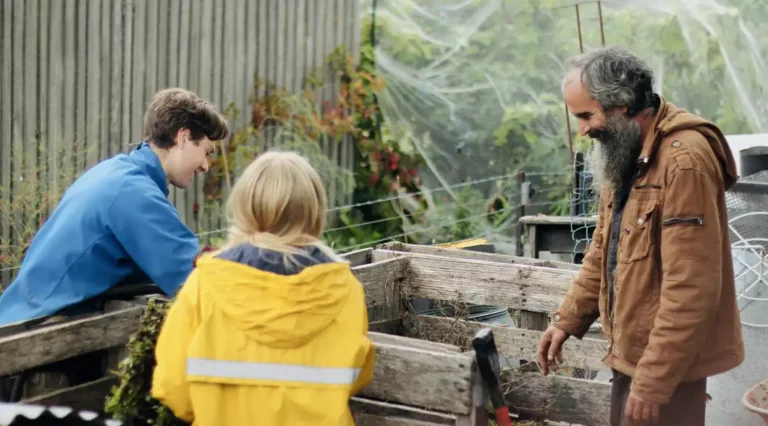about the book
Explore RetroSuburbia: chapter and section summaries and further resources
RetroSuburbia is part manual and part manifesto. The book shows how Australian suburbs can be transformed to become productive and resilient in an energy descent future. It focuses on what can be done by an individual at the household level (rather than community or government levels).
RetroSuburbia is a source of inspiration, introducing concepts and outlining patterns and practical solutions. It empowers people to make positive changes in their lives. As with David’s previous work, it is thought provoking and provocative.
If you are already on the path of downshifting and living simply, exploring RetroSuburbia will be a confirmation and celebration that you are on the right track and guide you on the next steps forward. If you are just beginning this journey, it provides a guide to the diversity of options and helps work out priorities for action. For people concerned about making ends meet in more challenging times, RetroSuburbia provides a new lens for creatively sidestepping the obstacles.
It is self-published through Melliodora Publishing – in itself an expression of the values and processes espoused in the book. It is directly marketed to the public through the networks that bypass the monopolistic online conglomerates.
RetroSuburbia is almost 600 pages in full colour with 556 photos and over 100 watercolour illustrations from permaculture illustrator Brenna Quinlan.
To get a taste for the book, follow the links below.
For those already reading RetroSuburbia, you will find extra resources and the links referred to in the book under each chapter heading.
Preface
This is the full Preface from RetroSuburbia – there is also an extended version of this history and background ‘A short personal and global history of retrofitting the suburbs’ at retrosuburbia.com/reading
RetrosSuburbia is part manual and part manifesto. It promotes the idea that Australian suburbs can be transformed to become productive and resilient into uncertain futures. It focuses on what can be done by individuals at the household level (rather than community or government levels).
The genesis of this book was an interview I did in 2004 with blogger Adam Fenderson (AKA Adam Grubb) including a question about the future of suburbia.1 That interview was my first public articulation of how the suburbs could be transformed by permaculture.2
The context for that interview was The End of Suburbia3 the first popular documentary about peak oil in which advocates of denser cities argued against ongoing suburban sprawl. This documentary reminded me of friendly debates with colleagues in the early 1980s, in which I argued that the critical strategy for a benign future was a permaculture retrofit and re-ruralisation of suburbia, rather than rebuilding our cities at higher densities to reduce car dependence.
I started to develop Aussie St as part of my ‘Retrofitting the suburbs’ presentation in 2005.4 This story, told in the second chapter of the book, illustrates the changes in a suburban street since the 1950s, and the subsequent retrofitting of houses and lifestyles to reflect a changing world. An article based on that presentation was published in the CSIRO Sustainability Network Newsletter,5 as interest in backyard food growing, chooks and household self-reliance grew.
A presentation in Western Australia, as part of a 2006 joint speaking tour with American peak oil educator Richard Heinberg, illustrated the very different responses my work was generating. The event was opened by the then state Minister for Energy Alannah MacTiernan, who stayed for both presentations. Professor Peter Newman – a prominent lifelong proponent of improved sustainability and liveable cities – attended and later criticised my work as a justification for continued urban sprawl and a relishing of the collapse of complex city functions.6 However, Aussie St inspired another person in the audience, Shani Graham, to start the Hulbert St community initiative in Fremantle7 one of the most inspirational examples of bottom-up, household, street and local community responses to the climate change and peak oil.
My Aussie St narrative continued to grow and morph with each presentation, developing a life of its own with names for the residents, and in 2012 I added a near-future scenario ‘The 2020 Second Great Depression’.8 This reflected my growing understanding of how bubble economics could act as a catalyst to precipitate economic contraction as the first stage in a much longer and slower energy descent process driven by peak oil and climate change. The Global Financial Crisis (GFC) of 2008 provided an early warning for an Australia still riding high on the resources boom. Nicole Foss’s writings at theoildrum.com and later at theautomaticearth.com strongly influenced my thinking as I shifted my lifelong focus from the energetic and ecological basis of human systems to understanding the role of money and finance.
In Future Scenarios workshops I focused on geopolitical-driven oil price shock, climate change driven-natural disaster and property bubble collapse as potential triggers for energy descent futures.9 These workshops generated empowering insights: the same household and community level strategies that reflected permaculture ethics and design principles would likely be beneficial in all these situations.
Samuel Alexander from the Simplicity Institute in Melbourne invited me to write an essay about ‘Retrofitting Suburbia’.10 It was written for environmental and community activists, urban planners and policy people and included a meta-analysis of Aussie St to better explain some of the counter-intuitive aspects to the urban densification debate. I thought it was a stepping stone on the way to completing my languishing book on retrofitting suburbia.
The central argument of my presentations, workshops and finally this book – that suburban food production capacity is a key factor in the adaptation of cities to challenging futures – has shifted from a slightly outrageous idea to a subject widely discussed by urban planning academics and activists.11
While I remain happy to engage in debates, this book is about something much more important: practical, ‘from the ground up’ solutions. The more people who have dirt on their hands while talking to their neighbours, the greater the chance that debates about a resilient future will be grounded in the abundance of nature and flexibility of human behaviour (rather than what we have lost and who’s to blame!).12
1. An extract of the original video interview is available at retrosuburbia.com/book/preface-1.
2. Although I had already articulated these ideas whilst teaching Permaculture Design Courses (PDCs).
3. Written and directed by Gregory Greene, 2004; see also endofsuburbia.com.
4. First presented with Aussie St at the Aldinga Eco-Arts Village in South Australia.
5. Holmgren (2013) ‘Retrofitting the suburbs for sustainability’ available from holmgren.com.au or retrosuburbia.com/book/preface-5.
6. Newman does nevertheless promote many of the same initiatives that I suggest for building urban resilience for energy constrained futures; see Newman (2009).
7. See Graham’s TedXPerth talk ‘Take a Street and Build a Community’ (2013); see also ‘On Hulbert St’ at ecoburbia.com.au or retrosuburbia.com/book/preface-7.
8. This scenario was first presented at the Wheeler Centre in Melbourne; see ‘Lunchbox/soapbox: David Holmgren on retrofitting the suburbs for sustainability’ at wheelercentre.com or retrosuburbia.com/book/preface-8
9. See ‘Futures framework for retrosuburbia’ (retrosuburbia.com/reading).
10. An updated version, ‘Retrosuburbia; the manifesto’, is at available at retrosuburbia.com/reading.
11. See, for example, Zainuddin & Mercer (2014) ‘Domestic Residential Garden Food Production in Melbourne, Australia: a fine-grained analysis and pilot study’ in Australian Geographer 45:465–484
12. For an extended version of the story the genesis of this book, see ‘A short personal and global history of retrofitting the suburbs’ at retrosuburbia.com/reading.
Resources
Coming soon
Introduction
The purpose of this book is to help those planning or engaged in a retrofit of their homes, gardens and lifestyles to be more self-reliant and resilient within the household and local neighbourhood. This promises both a more fulfilling life and multiple benefits for society and the environment.
You can use the strategies, design solutions and complementary options in this book as patterns (or templates) to make incremental and ongoing changes to life in low-density detached suburban housing in our cities, regional centres and small towns.
In this chapter
Local vs global audience
Structure of the book
Fields and domains of action
Retrosuburbia.com
Resources
Coming soon
Links
These links are taken directly from the footnotes in the book – we have put them here for easy access when reading the book. It is best if they are viewed in the context of the chapter.
holmgren.com.au download Essence of Permaculture
holmgren.com.au ‘Melliodora’
https://store.holmgren.com.au/product/test-physical-product/

 Finding a source of information that can equip an individual to go out into the world and deal with the ever-changing realities around them is difficult. I know firsthand that completing a degree in landscape architecture did not make me a landscape architect. I studied a range of courses concurrently including my first Permaculture Design Course, Catchment Management, Aquaculture, and even life drawing and graphic art. It takes years of experience and the synthesis of countless scenarios to turn a book into a living, breathing, valuable asset for sharing knowledge. And that is what RetroSuburbia is: a massive undertaking that happily holds the hand of those seeking a method, a manual or – could I say – a handbook for living that articulately clarifies and validates the how and why of a community-conscious approach to life.
Finding a source of information that can equip an individual to go out into the world and deal with the ever-changing realities around them is difficult. I know firsthand that completing a degree in landscape architecture did not make me a landscape architect. I studied a range of courses concurrently including my first Permaculture Design Course, Catchment Management, Aquaculture, and even life drawing and graphic art. It takes years of experience and the synthesis of countless scenarios to turn a book into a living, breathing, valuable asset for sharing knowledge. And that is what RetroSuburbia is: a massive undertaking that happily holds the hand of those seeking a method, a manual or – could I say – a handbook for living that articulately clarifies and validates the how and why of a community-conscious approach to life.




